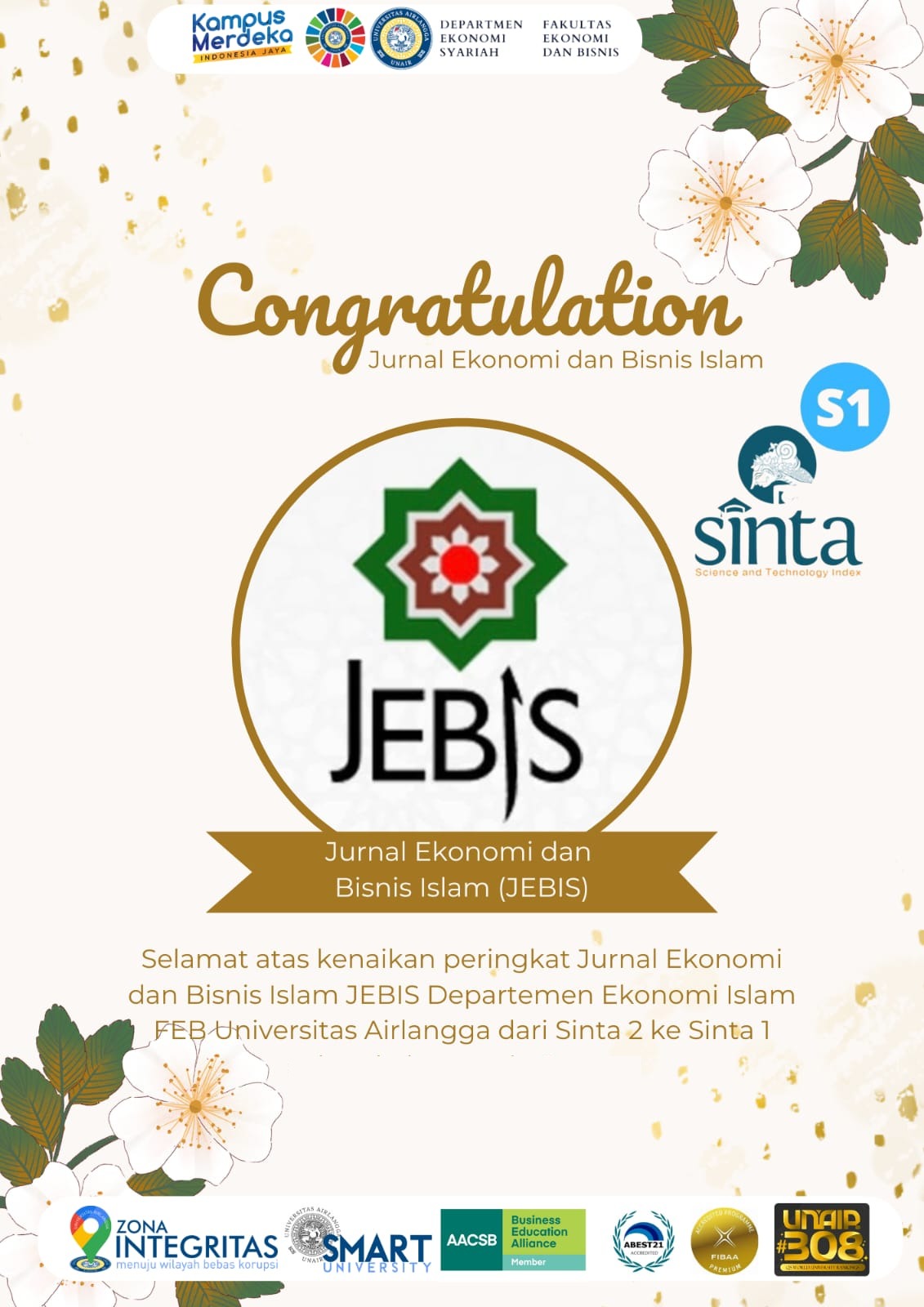ENVIRONMENTAL PERFORMANCE ENCOURAGES RETURN INVESTMENT IN CONSUMPTION COMPANIES: CASE ISLAMIC STOCK INDONESIA (2016-2020)
Downloads
As khalifah (leader), human beings are supposed to guard the earth. In this modern era, one way to do it can be by supporting the companies that maintain their environmental performance. As Muslims invest in Islamic indexes, they can take care of the earth at the same time. Therefore, this study aims to examine the behavior of investors in the environmental performance of companies listed in the Islamic index. The dependent variables are stock return, and the independent are market value added (MVA), PROPER value, and return on equity (ROE). The sample of this study is consumption companies registered with Indonesia Islamic Stock Index (ISSI) from2016 to 2020. There are 90 observational data in this study. Using the multiple regression analysis techniques, this study confirms that there is a significant positive effect of the PROPER and ROE on stock returns. At the same time, the MAV has no significant positive effect on stock returns. Many other variables should be investigated further regarding their effect on stock return in consumer goodscompanies, such as NPM, ROA, and DER. Investors may consider index PROPER as the benchmark for investment in Islamic stock. There is a high potential return based on environmental performance. If the company's PROPER value is good, then there is also an indication of a high investment return.
Alessi, L., Ossola, E., & Panzica, R. (2021). What greenium matters in the stock market? The role of greenhouse gas emissions and environmental disclosures. Journal of Financial Stability, 54, 100869. https://doi.org/10.1016/j.jfs.2021.100869
Anshori, M., & Iswati, S. (2019). Metodologi Penelitian Kuantitatif. Airlangga University Press.
Bobi, Y. (2020). Pengaruh Kebijakan Dividen dalam Moderasi Financial Performance terhadap Return Saham pada Sektor Pertanian yang Terdaftar di Bursa Efek Indonesia. Equator Journal of Management and Entrepreneurship (EJME), 8(1), 1–18. https://doi.org/10.26418/ejme.v8i1.35738
Brigham, E. F., Houston, J. F., & Yulianto, A. A. (2014). Dasar-Dasar Manajemen Keuangan. Salemba Empat.
Chang, E. C., & Dong, S. (2006). Idiosyncratic volatility, fundamentals, and institutional herding: Evidence from the Japanese stock market. Pacific Basin Finance Journal, 14(2), 135–154. https://doi.org/10.1016/j.pacfin.2005.09.001
Dewi, N. K. N., & Wirasedana, I. W. P. (2017). Pengaruh Kinerja Lingkungan terhadap Kinerja Ekonomi. E-Jurnal Akuntansi, 20(1), 526–554. https://ojs.unud.ac.id/index.php/Akuntansi/article/view/29119
Dharma, S. (2008). Pendekatan, Jenis, dan Metode Penelitian Pendidikan. Direktorat Tenaga Kependidikan Departemen Pendidikan Nasional.
Ghozali. (2018). Aplikasi Analisis Multivariate dengan IBM SPSS 25. Forum Ilmiah Pendidikan Akuntansi Universitas PGRI Madiun, 6(2).
Hardiyansah, M., Agustini, A. T., & Purnamawati, I. (2021). The Effect of Carbon Emission Disclosure on Firm Value: Environmental Performance and Industrial Type. The Journal of Asian Finance, Economics and Business, 8(1), 123–133. https://doi.org/10.13106/jafeb.2021.vol8.no1.123
Hariani, L. S. (2010). Analisis Pengaruh Economic Value Added (EVA) dan Rasio Keuangan terhadap Return Saham Syariah. Jurnal Ekonomi MODERNISASI, 6(1), 1–21.
Hartono, J. (2009). Teori Portofolio dan Analisis Sekuritas. BPFE.
Husnan, S., & Pudjiastuti, E. (2015). Dasar-Dasar Manajemen Keuangan, Edisi Ketujuh. UPP STIM YKPN. Yogyakart.
Kartini, K., & Hermawan, G. (2008). Economic Value Added dan Market Value Added terhadap Return Saham. Jurnal Keuangan Dan Perbankan, 12(3), 355–368. https://doi.org/10.26905/jkdp.v12i3.899
Kasmir, K. (2018). Analisis Laporan Keuangan (11th ed.). Raja Grafindo Persada.
Khanifah, K., Udin, U., Hadi, N., & Alfiana, F. (2020). Environmental Performance and Firm Value: Testing the Role of Firm Reputation in Emerging Countries. International Journal of Energy Economics and Policy, 10(1), 96–103. https://doi.org/10.32479/ijeep.8490
Manan, A. (2009). Aspek Hukum dalam Penyelenggaraan Investasi di Pasar Modal Syariah Indonesia. Kencana Prenada Media Group.
Martani, D., Mulyono, M., & Khairurizka, R. (2009). The effect of financial ratios, firm size, and cash flow from operating activities in the interim report to the stock return. Chinese Business Review, 8(6), 44–55.
Martani, D., Siregar, S. V., Wardhani, R., Farahmita, A., & Tanujaya, E. (2016). Akuntansi Keuangan Menengah berbasis PSAK (2nd ed.). Salemba Empat.
Nababan, L. M., & Hasyir, D. A. (2019). Pengaruh Environmental Cost dan Environmental Performance terhadap Financial Performance (Studi Kasus pada Perusahaan Sektor Pertambangan Peserta PROPER periode 2012-2016). E-Jurnal Ekonomi Dan Bisnis Universitas Udayana, 8(3), 259–286. https://doi.org/10.24843/eeb.2019.v08.i03.p03
Purwaningsih, E. (2017). Pengaruh Implementasi Kinerja Keuangan terhadap Return Saham yang Dimoderasi Corporate Governance. Jurnal Ilmiah Wahana Akuntansi, 12(2), 171–189. https://doi.org/10.21009/wahana.12.025
Rehman, A., Ullah, I., Afridi, F.-A., Ullah, Z., Zeeshan, M., Hussain, A., & Rahman, H. U. (2021). Adoption of green banking practices and environmental performance in Pakistan: a demonstration of structural equation modelling. Environmental, Development and Sustainability, 23, 13200–13220. https://doi.org/10.1007/s10668-020-01206-x
Rusmita, S. A., Syafira, F. N., & Afifa, O. M. (2020). The Effect of Environmental Disclosure on ISSI Company Stock Prices. International Journal of Innovation, Creativity and Change, 10(12), 488–501.
Samsul, M. (2006). Pasar Modal dan Manajemen Portofolio. Penerbit Erlangga.
Setyaningsih, R. D., & Asyik, N. F. (2016). Pengaruh Kinerja Lingkungan terhadap Kinerja Keuangan dengan Corporate Social Responsibility sebagai Pemoderasi. Jurnal Ilmu Dan Riset Akuntansi, 5(4), 1–15. http://jurnalmahasiswa.stiesia.ac.id/index.php/jira/article/view/282
Teresia, E. S. D., & Hermi, H. (2016). Pengaruh Struktur Kepemilikan, Ukuran Perusahana, dan Keputusan Keuangan terhadap Nilai Perusahaan dengan Pertumbuhan Perusahaan sebagai Variabel Moderating. Jurnal Magister Akuntansi Trisakti, 3(1), 73–94. https://doi.org/10.25105/jmat.v3i1.4969
Thenmozhi, M. (2000). Market Value Added and Share Price Behavior. Delhi Business Review, 1(1).
Van Horne, J. C., & Wachowicz, J. M. (2008). Fundamentals of Financial Management (13th ed.). Pearson Education Limited.
Wahyudi, M. F. (2009). Analisis Keuangan Perusahaan dengan Menggunakan Pendekatan Economic Value Added (MVA) Periode Tahun 2005-2007 (Studi pada PT Telekomunikasi Indonesia Tbk.). UIN Malang.
Wijaya, H. H., & Tjun, L. T. (2009). Pengaruh Economic Value Added terhadap Tingkat Pengembalian Saham pada Perusahaan yang Tergabung dalam LQ-45. Jurnal Akuntansi, 1(2), 180–200.
Yuniarti, D., & Litriani, E. (2017). Pengaruh Inflasi dan Nilai Tukar Rupiah terhadap Harga Saham di Sektor Industri Barang Konsumsi pada Indeks Saham Syariah Indonesia (ISSI) tahun 2012-2016. I-Finance: A Research Journal on Islamic Finance, 3(1), 31–52. https://doi.org/10.19109/ifinance.v3i1.1478
Copyright (c) 2022 JEBIS (Jurnal Ekonomi dan Bisnis Islam) | JOURNAL OF ISLAMIC ECONOMICS AND BUSINESS

This work is licensed under a Creative Commons Attribution-NonCommercial-ShareAlike 4.0 International License.
- Every manuscript submitted to JEBIS must obey to the policy and terms set by Journal of Economics and Business Islamic.
- Publication rights on the contents of manuscript published by JEBIS is owned by JEBIS under consent and approval by the corresponding author(s).
- Full text of electronic publication of manuscripts can be accessed free if used for the purpose of education and research according to copyright regulation.
- Share ” copy and redistribute the material in any medium or format
- Adapt ” remix, transform, and build upon the material
- You must give appropriate credit, provide a link to the license, and indicate if changes were made. You may do so in any reasonable manner, but not in any way that suggests the licensor endorses you or your use.
- You may not use the material for commercial purposes.
- If you remix, transform, or build upon the material, you must distribute your contributions under the same license as the original.
Creative Commons Attribution-NonCommercial-ShareAlike 4.0 International License.





.png)














